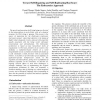Free Online Productivity Tools
i2Speak
i2Symbol
i2OCR
iTex2Img
iWeb2Print
iWeb2Shot
i2Type
iPdf2Split
iPdf2Merge
i2Bopomofo
i2Arabic
i2Style
i2Image
i2PDF
iLatex2Rtf
Sci2ools
EH
2000
IEEE
2000
IEEE
Toward Self-Repairing and Self-Replicating Hardware: The Embryonics Approach
The growth and operation of all living beings are directed by the interpretation, in each of their cells, of a chemical program, the DNA string or genome. This process is the source of inspiration for the Embryonics (embryonic electronics) project, whose final objective is the design of highly robust integrated circuits, endowed with properties usually associated with the living world: self-repair (cicatrization) and self-replication. The Embryonics architecture is based on four hierarchical levels of organization: 1) The basic primitive of our system is the molecule, a multiplexer-based element of a novel programmable circuit. 2) A finite set of molecules makes up a cell, essentially a small processor with an associated memory. 3) A finite set of cells makes up an organism, an application–specific multiprocessor system. 4) The organism can itself replicate, giving rise to a population of identical organisms. In the conclusion, we describe our ongoing research efforts to meet three ...
Application–specific Multiprocessor System | EH 2000 | Finite Set | Hardware | Robust Integrated Circuits |
| Added | 31 Jul 2010 |
| Updated | 31 Jul 2010 |
| Type | Conference |
| Year | 2000 |
| Where | EH |
| Authors | Daniel Mange, Moshe Sipper, André Stauffer, Gianluca Tempesti |
Comments (0)

